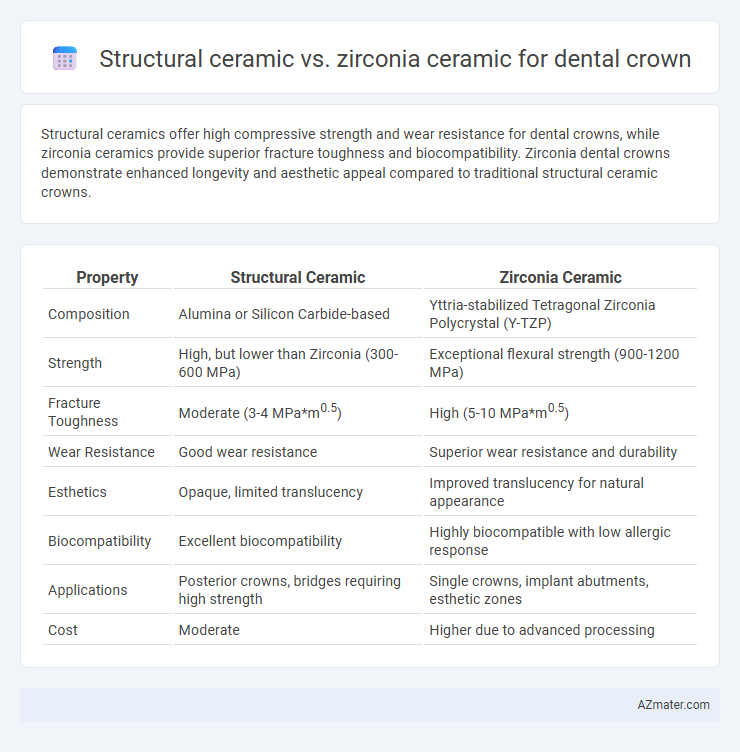Structural ceramics offer high compressive strength and wear resistance for dental crowns, while zirconia ceramics provide superior fracture toughness and biocompatibility. Zirconia dental crowns demonstrate enhanced longevity and aesthetic appeal compared to traditional structural ceramic crowns.
Table of Comparison
| Property | Structural Ceramic | Zirconia Ceramic |
|---|---|---|
| Composition | Alumina or Silicon Carbide-based | Yttria-stabilized Tetragonal Zirconia Polycrystal (Y-TZP) |
| Strength | High, but lower than Zirconia (300-600 MPa) | Exceptional flexural strength (900-1200 MPa) |
| Fracture Toughness | Moderate (3-4 MPa*m0.5) | High (5-10 MPa*m0.5) |
| Wear Resistance | Good wear resistance | Superior wear resistance and durability |
| Esthetics | Opaque, limited translucency | Improved translucency for natural appearance |
| Biocompatibility | Excellent biocompatibility | Highly biocompatible with low allergic response |
| Applications | Posterior crowns, bridges requiring high strength | Single crowns, implant abutments, esthetic zones |
| Cost | Moderate | Higher due to advanced processing |
Introduction to Dental Ceramics
Dental ceramics for crowns primarily include structural ceramics like alumina and zirconia, each offering distinct mechanical properties and aesthetics. Zirconia ceramic, known for its superior flexural strength (up to 1200 MPa) and fracture toughness, provides enhanced durability and longevity in dental restorations compared to traditional structural ceramics. Both types mimic natural tooth appearance but zirconia stands out with improved translucency and biocompatibility, making it a preferred material for modern dental crowns.
Overview of Structural Ceramics in Dentistry
Structural ceramics in dentistry are engineered materials designed to provide high strength, durability, and biocompatibility for dental restorations such as crowns. These ceramics, including alumina and lithium disilicate, offer excellent fracture resistance and esthetic qualities crucial for long-lasting dental crowns. Zirconia ceramic, a subtype of structural ceramics, excels with superior toughness and wear resistance, making it a preferred choice for posterior crowns requiring enhanced mechanical performance.
Zirconia Ceramic: Composition and Properties
Zirconia ceramic crowns are composed primarily of zirconium dioxide (ZrO2), often stabilized with yttria (Y2O3) to enhance strength and fracture toughness. This material exhibits exceptional biocompatibility, high flexural strength (900-1200 MPa), and superior wear resistance compared to traditional structural ceramics like alumina. Its translucency and ability to be precisely milled make zirconia ceramic crowns highly esthetic and durable for long-term dental restorations.
Strength and Durability Comparison
Structural ceramics and zirconia ceramics differ significantly in strength and durability for dental crowns; zirconia exhibits superior fracture toughness with values around 9-10 MPa*m^0.5 compared to traditional structural ceramics like alumina, which typically range between 3-5 MPa*m^0.5. The high flexural strength of zirconia, often exceeding 900 MPa, ensures enhanced resistance to chipping and cracking under occlusal forces, making it ideal for posterior crowns subject to intense masticatory stress. Structural ceramics, while biocompatible and aesthetically pleasing, generally lack the mechanical robustness of zirconia, resulting in lower long-term durability especially in high-stress oral environments.
Aesthetic Outcomes: Structural vs Zirconia Ceramics
Zirconia ceramics provide superior aesthetic outcomes for dental crowns due to their translucency and tooth-like color, closely mimicking natural enamel compared to structural ceramics. Structural ceramics, such as alumina, often offer higher strength but lack the same level of translucency, resulting in a less lifelike appearance. The advanced optical properties of zirconia make it the preferred choice for anterior restorations where aesthetics are critical.
Biocompatibility and Patient Safety
Structural ceramics such as alumina and zirconia ceramic exhibit excellent biocompatibility, with zirconia demonstrating superior resistance to plaque accumulation and lower cytotoxicity, enhancing patient safety in dental crown applications. Zirconia's high fracture toughness and chemical inertness reduce the risk of allergic reactions and inflammatory responses compared to traditional structural ceramics. Both materials ensure long-term durability, but zirconia's enhanced biocompatibility makes it the preferred choice for patients prioritizing safety and soft tissue health.
Clinical Performance and Longevity
Zirconia ceramic crowns exhibit superior clinical performance due to their high fracture toughness and excellent biocompatibility, making them resilient under masticatory forces and less prone to chipping compared to traditional structural ceramics. Structural ceramics, such as alumina, offer good strength but generally lack the durability and wear resistance of zirconia, resulting in a shorter lifespan for dental crowns made from these materials. Clinical studies highlight zirconia's enhanced longevity, with survival rates exceeding 90% over a 10-year period, establishing it as the preferred material for long-lasting dental restorations.
Preparation and Handling Differences
Structural ceramics for dental crowns typically require minimal tooth reduction due to their high strength, enabling conservative preparation. Zirconia ceramics demand more precise and aggressive preparation to accommodate their thickness and ensure proper fit and bonding. Handling differences include zirconia's need for specialized sintering processes and adhesive protocols, while structural ceramics often allow conventional cementation techniques.
Cost-Effectiveness and Accessibility
Structural ceramics for dental crowns provide a balance of affordability and durability, making them a cost-effective option for patients seeking reliable restoration with moderate budget constraints. Zirconia ceramics, while often more expensive upfront due to their superior strength, longevity, and esthetic qualities, offer long-term value by reducing the need for frequent replacements or repairs. Accessibility to structural ceramics is generally higher in various clinical settings, whereas zirconia crowns may require specialized equipment and expertise, potentially limiting availability in some regions.
Choosing the Right Ceramic for Dental Crowns
Selecting the ideal ceramic for dental crowns depends on factors such as strength, aesthetics, and biocompatibility. Structural ceramics like alumina offer superior fracture resistance and durability, making them suitable for molars and high-stress areas. Zirconia ceramics combine high strength with translucency, providing a natural appearance for both anterior and posterior crowns while ensuring excellent long-term performance.

Infographic: Structural ceramic vs Zirconia ceramic for Dental crown
 azmater.com
azmater.com